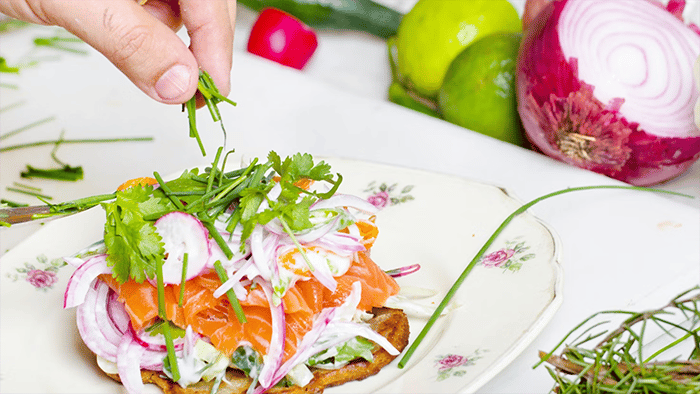- Healthy Snacking Is Important
- Portion Control Is Crucial
- Do Not Exceed Energy Intake
- Do Not Cut Out Fats
- More Fruits And Vegetables, Less Eating Out
- Be Creative And Involve Them In The Process
Class 2 is a crucial growing age for children. Since they have just turned 7 or 8, they have outgrown their pre-school newness and have become accustomed to the pressure and requirements of school. This makes it the ideal time to provide their body with nutrition and introduce them to different healthy food groups to develop a healthy balanced diet. After all, French fries can no longer count as their daily vegetable portion, not if you wish to restrict the entry of lifestyle diseases into your household.
Also, early introduction of diverse foods help reduces the risk of food intolerances and allergies in life. Therefore, to provide your growing second grader with the necessary nourishment for healthy development, here are some guidelines on forming healthy eating habits and having a balanced diet.
Tips On Exploring A Balanced Diet In Second Grade
1. Healthy Snacking Is Important

Healthy snacking is essential nowadays as most kids indulge readily in available and convenient packaged fast foods with no concern for nutrition. Therefore, it is important for parents to check the frequency and quality of snacking. Do not allow more than one to two snacks in a day, including school tiffin. Also, make sure the snacks are either homemade or natural, like hummus and vegetable sticks, apples and nut butter, or Greek yogurt and berries.
2. Portion Control Is Crucial
Portion Control is essential for children. Unlike adults, the size of a kid’s stomach is much smaller. Therefore, their plate should be amply loaded with micronutrients like vitamins, minerals, and macronutrients like carbohydrates, proteins, fats, and dietary fiber. But the serving amount should be age appropriate, no more than a 9-inch plate served with a serving each of fruits or vegetables, whole grains, lean meat or vegetarian protein, and legumes, while fruits can play a role in snacks or desserts. Remember, while it is important to not waste food, it is also crucial to identify your kid’s appetite, age-appropriate portions, and nutritional needs.
3. Do Not Exceed Energy Intake
To have a balanced diet, it is essential to not exceed calorie intake. Since proteins and carbohydrates provide the same amount of energy, while fats offer the highest amount, it is important to make sure your second grader’s diet has their macronutrients in correct amounts. While carbs should comprise 45 to 50% of your daily energy intake, proteins must constitute 25 to 35% and fats at least 15 to 25% of daily calorie consumption. This makes sure your second grader’s plate is balanced. Remember to keep vegetables, fruits, and whole grains as the main source of carbohydrates in your kids’ diet.
4. Do Not Cut Out Fats

Most people equate fat with poor health and obesity but that is not the case. Consumption of healthy fats is crucial for your growing kid as it gives their body the necessary solvent to dissolve essential vitamins. Cut out trans-fat from fast and processed foods completely, and moderate consumption of saturated fats from red meat and high-fat dairy, while increasing the amount of unsaturated fats like fatty fish, eggs, and nuts in your second grader’s diet. This will also imbue them with strength and improve their vision.
5. More Fruits And Vegetables, Less Eating Out
Kids would rarely opt for fruits and vegetables instead of eating out or prefer healthy dishes instead of fast-food takeout. But the approach has to be different towards healthy foods. Fruits and vegetables should not be associated with punishment and negative emotions, they should be similar in preference and appreciation to chicken nuggets or French fries. And this will develop as a habit in second graders only if they follow the same in their parents.
6. Be Creative And Involve Them In The Process

No kid will eat steamed kale or broccoli if it is plated as it is. Kids enjoy fun, adventure, creativity, and spontaneity. Second graders will even eat fish if they find a dish tasty and appealing enough. Therefore, it is ideal to plate homemade, even simple dishes creatively, to gain their attention and appreciation. Also, involve them in the cooking process. Not only are second graders good helpers, but also great learners. The lessons they learn in the kitchen today will be the ones they carry throughout their life. Therefore, whether it is bhindi masala or naan pizza, make home-cooked food fun, together with your second grader.
Conclusion
Maintain open communication and honesty with your kid, even regarding their food. Instead of shouting when frustrated, try reasoning with them, or offering them options. This will not ruffle your newly independent second graders' sense of self, and build trust, instead. A balanced diet also comes with a balanced mindset, so remember these easy tips to explore forming a balanced diet with your kid in class 2 and have fun with food, together.
Tarishi Shrivastava is a young writer who has covered a range of topics on children's health, including nutrition, fitness, sleep, and parent-child bonding. With a keen interest in simplifying wellness for parents, she brings a practical and engaging approach to her writing. Beyond work, she enjoys exploring new ideas, staying curious, and creating meaningful content.
The views expressed are that of the expert alone.
The information provided in this content is for informational purposes only and should not be considered a substitute for professional medical advice, diagnosis, or treatment. Always seek the advice of your physician or another qualified healthcare provider before making any significant changes to your diet, exercise, or medication routines.
References
https://www.nin.res.in/rdabook/brief_note.pdf;
https://www.nin.res.in/downloads/DietaryGuidelinesforNINwebsite.pdf
https://www.nin.res.in/RDA_Full_Report_2024.html;
https://www.ijfcm.org/html-article/18750;
https://www.cry.org/blog/importance-of-nutrition-for-children-in-india/;
https://fssai.gov.in/upload/knowledge_hub/852185f89a7fc009c5Book_Do_You_Eat_Right_16_10_2020.pdf;










